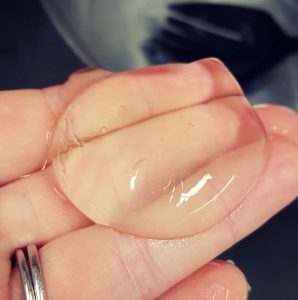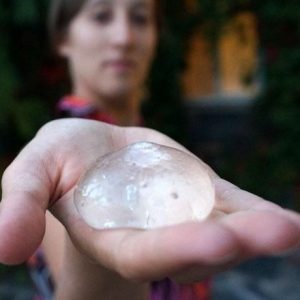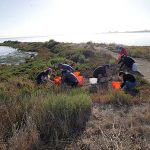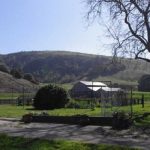Blog
Make Edible Water Bottles
How to make edible water bottles at home!
CuriOdyssey guests got to try edible water bottles at our May First Friday Family Night. Through the process of spherification, this activity will create an edible, gelatinous membrane around a blob of water! Your family can think about design solutions for environmental problems as you experiment with this possible substitute for plastic water bottles. #FamilyConservation

Materials:
- 1 g sodium alginate (1/2 teaspoon or a tad more. Tried with less (1/8 t, ¼ t) and found that the membrane was too thin)
- 5 g calcium lactate
- A scale
- 3 bowls:
- Bowl 1: 1 cup drinking water
- Bowl 2: 4 cups of water
- Bowl 3: for rinsing “water bottles”
- Deep spoon (eg ladle, soup spoon)
- Slotted spoon
- Immersion blender
- Food coloring (2 colors)

A CuriOdyssey Science Educator demonstrating edible water bottles at a First Friday Family Night event!
Ahead of time:
Wash all bowls and utensils to make sure that they’re food safe.
Steps to make ‘edible water bottles’:
- Dissolve Sodium Alginate in Water: Add one gram (around ½ t) of sodium alginate to the bowl containing one cup of drinking water. Use the hand mixer or immersion blender to combine the two ingredients thoroughly. Once the sodium alginate is full dissolved, let the solution sit for 15-30 minutes to ensure there are no air bubbles.
- Dissolve Calcium Lactate in Separate Bowl: Take five grams of calcium lactate and add it to the large bowl holding four cups of water. Mix the solution well using an ordinary whisk or mixing spoon. Make sure it is completely dissolved.
- Transfer Sodium Alginate to Calcium Lactate Bath: Take your curved spoon or ladle and scoop up the sodium alginate solution and gently place it into the calcium lactate bath. It will start to form a sphere immediately.
- Stir the Solution: Once you see that the spheres have taken shape, gently stir the solution for about three minutes to help the gel fully form.
- Water Blobs to Water Bowl: Take a slotted spoon and remove the water balls. Next, place them in the small bowl filled with regular water to stop the reaction.

Image from designboom.com
Suggested Questions:
- What are some advantages to the water blob? Disposable plastic water bottles? Reusable water bottles?
- Do you think that this is a viable alternative to plastic water bottles? Why or why not? What would improve it?
- Can you think of uses for the water blob?
Materials in the water blob:
“Alginate is derived from brown seaweed. Technically, it is a type of carbohydrate known to chemists as a polysaccharide. This molecule is also called a hydrocolloid, or a gum, because it has the ability to thicken or gel water. But unlike other hydrocolloids, such as gelatin or starch, alginate will thicken or gel a water-based liquid only in the presence of ions such as calcium. Sodium alginate is the sodium salt of alginate. “
Read more! Courtesy of this site.
Spherification: Food Science in Action
“Spherification is a process with culinary roots. It’s popular in molecular gastronomy, where chefs take a liquid and form it into spheres which look and feel like caviar.
There are two types of spherification: direct and reverse. The water blobs recipe is an example of direct spherification, where sodium alginate, a gelling solution, is mixed into your preferred liquid (this could be water or fruit juice). That mixture is then dropped into a solution, usually calcium chloride, to create a thin gel shell. We use calcium lactate instead of calcium chloride in this instance to create a more tender and eatable shell.” Again, we recommend this read to learn further about the process!
#CuriOdyssey #Science #Zoo #FamilyConservation
Sources & Resources:
Join the CuriOdyssey Community
LOCATION
1651 Coyote Point Drive
San Mateo, CA 94401
Ohlone Land Acknowledgement
650-342-7755
info@curiodyssey.org
CuriOdyssey is a 501(c)(3) non-profit, Tax ID 94-1262434



